-
What is 5G, and Why is it Important for UI/UX?
- Speed and Latency: Explain how 5G’s faster speeds (up to 100x faster than 4G) and lower latency significantly improve loading times and enable more complex interactions.
- Capacity for More Devices: Describe how 5G’s ability to handle more simultaneous connections supports seamless experiences, especially in crowded spaces.
- Potential for New Use Cases: Introduce how 5G could bring new user experiences, such as augmented reality (AR) and virtual reality (VR), to mobile apps.
-
Enhanced Mobile Experiences with 5G
- Instant Load Times: Discuss how 5G reduces load times, meaning designers can worry less about “weight” of assets like high-quality images or videos.
- Richer Media: Explain that with faster speeds, designers can incorporate higher-resolution images, videos, and interactive content without sacrificing performance.
- Real-Time Interactions: Cover the potential for real-time, dynamic content that adjusts based on user interactions, especially useful in social media, e-commerce, and gaming apps.
-
5G and Immersive Technologies in UI/UX
- Augmented Reality (AR) and Virtual Reality (VR): With 5G, AR and VR experiences can now be delivered seamlessly on mobile. Explain how designers can leverage these technologies to create immersive shopping experiences, virtual tours, and interactive tutorials.
- 3D and Haptic Feedback: Describe how 5G supports 3D content and tactile feedback, adding new dimensions to user interaction and increasing engagement.
-
New Design Challenges with 5G
- Balancing Rich Media with Usability: Faster speeds can tempt designers to overuse heavy assets. Discuss how to maintain a balance, ensuring design elements enhance UX without overwhelming the user.
- Battery Life Considerations: Highlight that 5G may increase battery usage, meaning designers should remain mindful of optimizing experiences that are battery-friendly.
-
signing for Edge Computing and AI-Powered Experiences
- Edge Computing: Explain how 5G enables edge computing, where data processing happens closer to the user. This can improve performance and enable real-time AI experiences without compromising speed.
- AI-Driven Features: Describe the potential for AI-powered personalization, recommendation systems, and voice recognition, which can now run more effectively on 5G-powered apps.
Disclaimer: The information shared in this post, including data, news, blogs, insights, case studies, etc., is sourced from publicly available materials. While we strive for accuracy, it may not fully reflect the views or verifications of the individuals or organizations mentioned. Readers are advised to verify details independently for complete accuracy.



